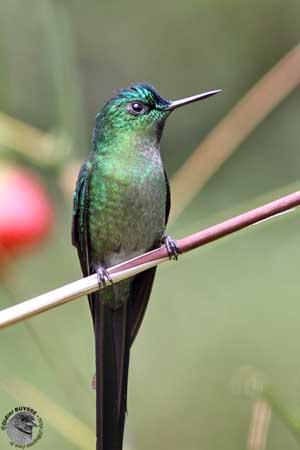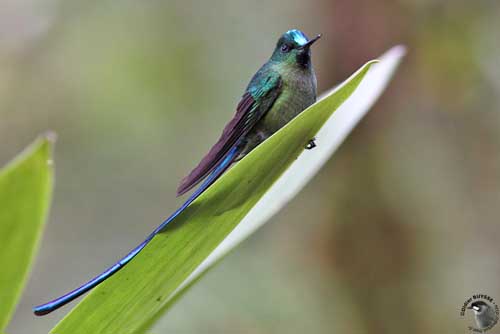
Fr: Sylphe à queue d’azur
All : Himmelssylphe
Esp: Silfo de King
Esp (Colombia): Cometa Verdiazul
Esp (Venezuela): Colibrí Coludo Azul
Ital: Silfide codalunga
Nd: Langstaartnimf
Sd: Grönstjärtad sylf
Photographer:
Didier Buysse
Vision d’Oiseaux
Text by Nicole Bouglouan
Sources:
HANDBOOK OF THE BIRDS OF THE WORLD Vol 5 by Josep del Hoyo-Andrew Elliott-Jordi Sargatal - Lynx Edicions - ISBN: 8487334253
A GUIDE TO THE BIRDS OF COLOMBIA by Steven L. Hilty and William L. Brown - Princeton University Press – ISBN 069108372X
BirdLife International (BirdLife International)
Wikipedia, the free encyclopaedia
Long-tailed Sylph
Aglaiocercus kingii
Apodiforme Order – Trochilidae Family
BIOMETRICS:
Length: Male: 16-19 cm, including the tail of 12 cm – Female: 9,7-11,7 cm
Weight: M: 5-6 g – F: 4,7 g
DESCRIPTION:
This lovely sylph is the only member of genus Aglaiocercus found on the east slopes of the Andes, but this species occurs on both E and W slopes.
The adult male has glittering, bronzy metallic green upperparts and slightly duller olive underparts. There is a small blue or violet throat patch.
The flight feathers are dark brown. On the tail, outer rectrices are very long whereas central ones are short. Tail feathers are green and violet above, and bluish-black below.
On the head, the crown is shining emerald green, turning dark green towards the nape.
The short bill is black (13 mm). The eyes are dark brown, with white postocular spot. Legs and feet are blackish.

The female has cinnamon underparts with white throat and breast lightly spotted green. Upperparts are shining green. The tail is shorter, notched, dark blue green. Outer rectrices are tipped white. On the metallic green head, we can see a short white malar stripe.
The immature resembles adult female, but it has slightly buffy underparts with diffuse green spots. There is a concealed white patch on the lower back.
There are six subspecies:
A.k. margarethae is found in NC and coastal Venezuela. This race has paler green upperparts than nominate.
A.k. caudatus occurs in W Venezuela and N Colombia. This one has purple-blue tail and lacks the blue throat spot.
A.k. emmae is found in C Andes of N Colombia to W Andes of S Colombia and NW Ecuador. This race has longer bill. Its plumage is paler and duller green with bright green throat.
A.k. kingii (here described) is found in E Andes of Colombia.
A.k. mocoa occurs in C Andes of S Colombia, Ecuador and N Peru. This one is more glittering green above. The throat patch is sapphire-blue to purple.
A.k. smaragdinus is found in E Andes of Peru and W and C Bolivia. This race has shorter tail and greenish-blue throat. The female has bronzy-green upperparts, more bluish-green crown, chestnut wash on back and green discs on throat.
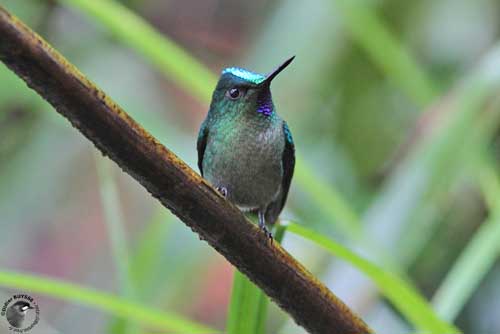
VOICE: SOUNDS BY XENO-CANTO
The Long-tailed Sylph, like many Trochilidae species, gives high-pitched monosyllabic chirps and whistles. The short calls are given by both sexes.
HABITAT:
The Long-tailed Sylph occurs in humid forest borders, bushy clearings, second growth woodlands and gardens. It usually avoids entering the forest.
This species is visible between 900 and 3000 metres of elevation.
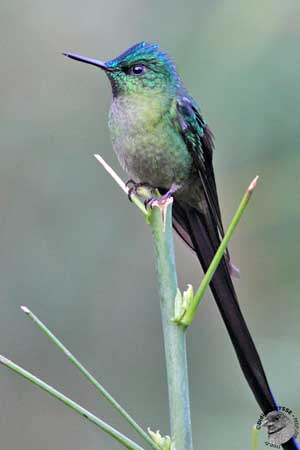
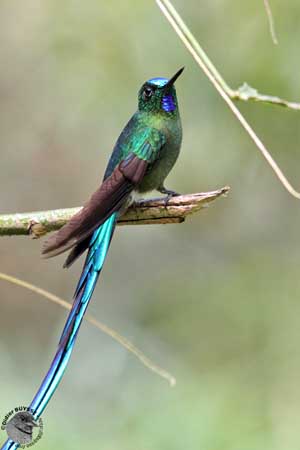
RANGE:
See above in “subspecies”
BEHAVIOUR:
The Long-tailed Sylph feeds on nectar and insects. Its feeding behaviour can be fairly complex and includes trap-lining (the bird follows a circuit of specific plant species or feeding sites), territorial defence during which it may become aggressive, and nectar robbing. It pierces the base of the corolla and takes the nectar in this way instead to enter the bill into the corolla.
This species gathers with other hummingbirds at abundant food sources such as the canopy of flowering trees.
It occasionally hovers, and may cling to feed at flowers. It also performs flycatching from perches and hawks for flying insects. It feeds primarily at tree tops, but it also visits small shrubs and can be seen in high-elevation grasslands.
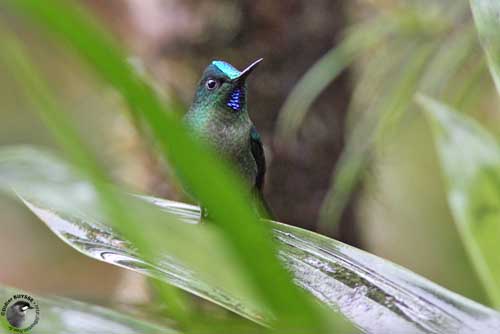
At the beginning of the breeding season, they become more territorial. The male uses aerial and intimidation displays to defend the territory.
Females are attracted by the beautiful long glossy tail displayed during the flight. The male performs a U-shaped flight which enhances the long tail following all its movements. However, both mates reproduce with more than one mate, and separate after copulation.
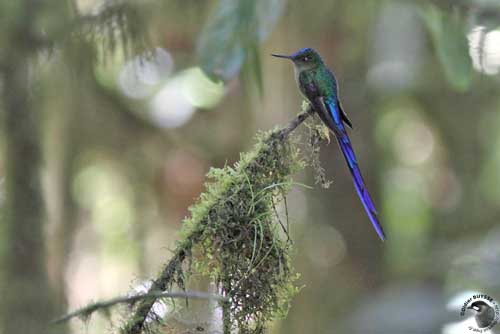
The Long-tailed Sylph performs mainly altitudinal movements, moving from pre-montane areas to higher regions, up to 2500-2700 metres and more.
FLIGHT:
The Long-tailed Sylph male’s long tail makes the flight cumbersome, and it must show a certain level of strength to fly and survive. But females are attracted by this long tail and the male’s strength.
REPRODUCTION:
This species may breed throughout the year.
The nest of the Long-tailed Sylph is a bulky, domed nest with a side entrance. It is made with moss and plant fibres. It is attached to twig or branch, and sometimes camouflaged with leaves. It may have a dangling tail of moss below.
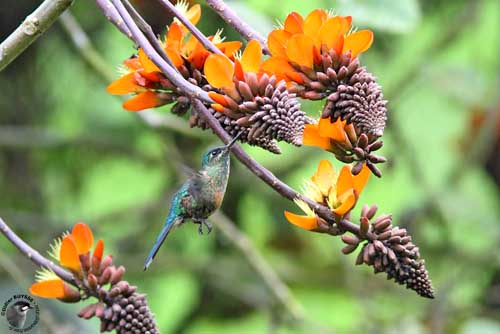
The female lays two white eggs, and incubates alone during 15-17 days, while the male defends the territory and its feeding areas. The chicks are fed by the female by regurgitation directly into their mouths. She broods them during one or two weeks, and they fledge about three weeks after hatching.
DIET:
The Long-tailed Sylph feeds primarily on nectar from small flowers of several trees and plant species. It also visits bird feeders for sugar water. It takes small spiders. Insects are caught in flight or from perch.
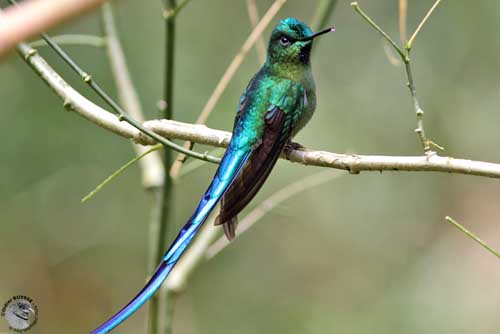
PROTECTION / THREATS / STATUS:
The Long-tailed Sylph is common to locally abundant, according to the range and the habitat. It could be threatened in Colombia and Ecuador by habitat destruction, due to cattle-raising which may affect the nature flora, involving a decrease in food plant.
However, the species is not currently threatened.
